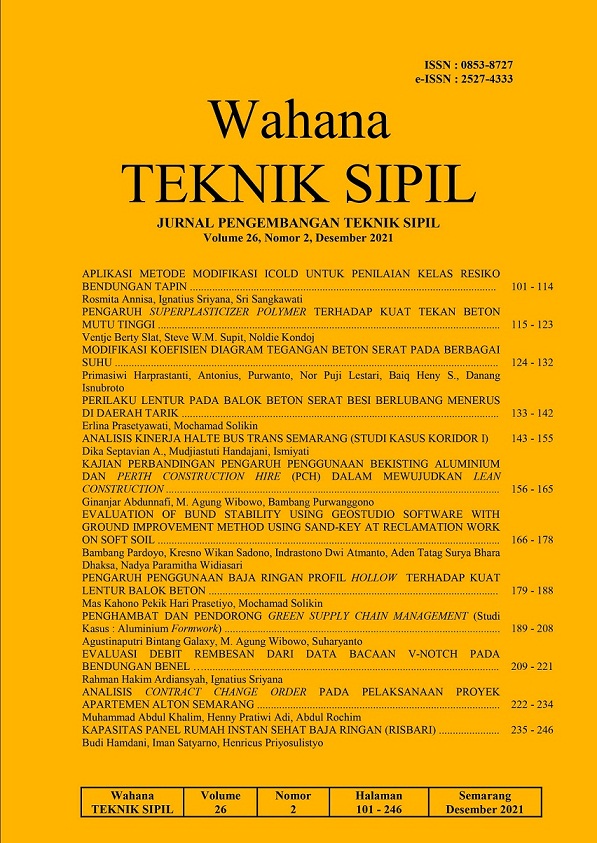EVALUATION OF BUND STABILITY USING GEOSTUDIO SOFTWARE WITH GROUND IMPROVEMENT METHOD USING SAND-KEY AT RECLAMATION WORK ON SOFT SOIL
DOI:
https://doi.org/10.32497/wahanats.v26i2.3131Keywords:
Reclamation, hydraulic fill, soft soil, bund, critical height, ground improvement, sand-key, safety factorAbstract
The use of sand-key reclamation works in soft and very soft soils to increase the stability of the bund construction. Reclamation using the hydraulic fill method requires a stable embankment structure to withstand the potential for landslides from landfills, and in sea areas with very soft subgrade soils, with small undrained cohesion values causes the bund to be unstable and do not exceed the critical limit. The purpose of this study is to evaluate the improvement of soft soil in bund construction so that it is stable using GeoStudio. The Bund stability analysis results show that the value of the sand-key depth depends on the variation in the depth of the seabed. At a seabed depth of -6 m, there is a sand-key depth of 7 m, -5 m the sand-key depth of 10 m, -4 m thesand-key depth of 10 m, -3 m the sand-key depth is 5 m. The final safety number of 1.404,1.438,1,675, and 1.354 respectively.References
Balasubramaniam, A.S., Cai, H., Zhu, D., Surarak, C., & Oh, E.Y.N., 2010, Settlements of embankments in soft soils. Geotechnical Engineering, 41(2), 1-19.
Das, B.M., Endah, N., & Mochtar, I.B., 2002, Mekanika Tanah (Prinsip-prinsip Rekayasa Geoteknis) (Y. Sianipar (ed.)). ERLANGGA.
Han, J., 2015, Principles and Practice of Ground Improvement. JOHN WILEY & SONS, INC.
Hartlen, J., Wolski, W., Lechowicz, Z., Szymanski, A., Baranski, T., Bergdahl, U., Carlsten, P., & Larsson, R., 1996, Embankments on Organic Soil (J. Hartlen & W. Wolski (eds.)). Elsevier Science B.V.
Hoff, J. V., 2012, Hydraulic Fill Manual. In Hydraulic Fill Manual. https://doi.org/10.1201/ b13077
Huda, M. C., 2013, Pengaturan Perizinan Reklamasi Pantai Terhadap Perlindungan Lingkungan Hidup. Perspektif, 18(2), 126. https://doi.org/ 10.30742/
Kassou, F., Bouziyane, J. Ben, Ghafiri, A., & Sabihi, A., 2020, Slope Stability of Embankments on Soft Soil Improved with Vertical Drains. Civil Engineering Journal, 6(1), 164”“173.
Look, B., 2007, Handbook of Geotechnical Investigation and Design Table (Vol. 6, Issue 2). Taylor & Francis Group.
Mansikkamäki, J., & Länsivaara, T., 2013, Stability improvement methods for soft clays in a railway environment. 18th International Conference on Soil Mechanics and Geotechnical Engineering: Challenges and Innovations in Geotechnics, ICSMGE 2013, 1317- 1320.
Shibata, T., Nishimura, S., Fujii, M., & Murakami, A., 2015, Evaluation of strength of soft ground improved by vacuum consolidation. Geotechnical Engineering, Geotechnical Engineering Journal,(46)1, 95-102.
Xie, S.H., Liu, S.Y., & Du, G.Y., 2014, Evaluation of application effect of soft marine clay foundation reinforced by new dry jet mixing piles. China Journal of Highway and Transport, issue , 8-14.
Zaika, Y., Suryo, E.A., 2019, Design of improved lime expansive soil for embankment of flexible pavement. International Journal of GEOMATE, (17) 60, 90-95.
Zukri, A., Nazir, R., Ng, K.S., 2018, The Settlement Evaluation of Improved Soft Clay Using LECA Replacement Technique. Proceeding 20Th SEAGC- 3Th AGSSEA Conference In Conjunction With22Nd Annual Indonesian National Conference On Geotechnical Engineering, Jakarta, Indonesia.
Downloads
Published
Issue
Section
License
Authors who publish with this journal agree to the following terms:Authors retain copyright and grant the journal right of first publication with the work simultaneously licensed under a Creative Commons Attribution License that allows others to share the work with an acknowledgement of the work's authorship and initial publication in this journal.
Authors are able to enter into separate, additional contractual arrangements for the non-exclusive distribution of the journal's published version of the work (e.g., post it to an institutional repository or publish it in a book), with an acknowledgement of its initial publication in this journal.
Authors are permitted and encouraged to post their work online (e.g., in institutional repositories or on their website) prior to and during the submission process, as it can lead to productive exchanges, as well as earlier and greater citation of published work (See The Effect of Open Access).






